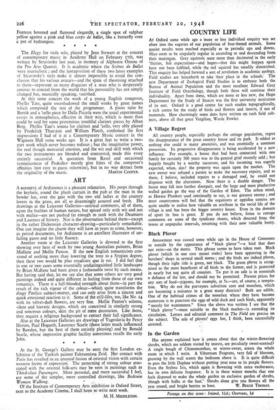MUSIC
Two works by Stravinsky, new as far as this country is concerned, would have made an eventful week twenty years ago, but even his warmest admirers must admit that there is every reason now for their passing unnoticed. It is not simply that Stravinsky shuns all the qualities which made his original reputation—brilliant colour, violent rhythms and provocative harmony. Their disappearance was, in a sense, gradual and spread right over the 'twenties, so that though we lost orchestral colour in Les Noces (5923) we were not deprived of the other two for another ten years. This is not to say that Stravinsky's present productions lack a certain rhythmic interest (the Scherzo a la Russe of 5944, coinciding with the new encouragement of Russian patriotism in the U.S.S.R.' was even a sort of pastiche of Stravinsky's own earlier manner) but it is rarefied now and often masked or deformed by extraneous elements.
This was the case in the Scenes de Ballet given at Covent Garden on February sith, where pastiche of music-hall or ballroom music stood side by side with hieratic effects which are all Stravinsky's own, however oddly placed they may seem. These ballet scenes were originally written for Billy Rose's revue, The Seven Lively Arts, and it would be a mistake to forget their origin and demand anything more than good workmanship, wit (though that is of a dated kind and smells strongly of the 'twenties) and a certain chic. That may seem a come-down for the author of Fire-bird, Petrushka and the Rite of Spring ; but Stravinsky, or a large part of Stravinsky, has got left behind in the Paris of the 'twenties, where such things were regarded as correct and modern. The Scenes de Ballet stand to, say, Petrushka in much the same relationship as a copy of Vogue to a narrative poem by Pushkin. It may be in accordance with a theory (in fact, it almost certainly is that) or simply for the sake of a highly-paid commission—and after all, there is nothing inherently disgraceful in a serious composer writing for a revue— but Stravinsky's old admirers will surely feel a twinge when they see a ballet in which Stravinsky's music is really the least interesting part of the whole performance. Andre Beaurepaire's scenery at Covent Garden was smart and pretty in the same Vogue manner, only smarter and prettier than Stravinsky's music, I thought. Miss Fonteyn hovered and fluttered elegantly, a single spot of sulphur yellow against a pink and blue corps de ballet, like a butterfly over a pot of hydrangeas.
* * * The Elegy for viola solo, played by Jean Stewart at the concert of contemporary music in Academy Flail on February r7th, was written by Stravinsky last year, in memory of Alphonse Onnou of the Pro Arte Quartet. It is academic where the Scenes de Ballet were journalistic ; and the juxtaposition of these two latest examples of Stravinsky's style make it almost impossible to avoid the con- clusion that his various avatars—and the spate of theorising attached to them—represent so many disguises of a man who is desperately anxious to conceal from the world that his personality has not simply changed but, musically speaking, vanished.
At this same concert the work of A young English composer, Phyllis Tate, quite overshadowed the small works by great names which composed the rest of the programme. A piano suite by Bartok and a 'cello piece by Dalla Piccola were the usual experimental essays in atmospherics, effective in their way, which is more than could be said for some pretentious youthful clarinet pieces by Alban Berg. Phyllis Tate's sonata for clarinet and 'cello, very ably played by Frederick Thurston and William Pleeth, confirmed the first impressions I had of it at a Contemporary Music concert' in the Wigmore Hall some weeks ago. It is a great feat to write a two- part work which never becomes tedious 7 but the imaginative power, the real though mercurial emotion, and 'the wit and skill with which the two instruments are blended and contrasted, made this essay entirely successful. A quotation from Ravel and occasional reminiscences of Prokofiev merely give hints of the composer's affinities (not easy to guess otherwise), but in no way detract from































 Previous page
Previous page